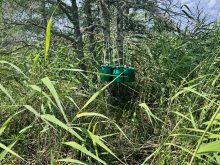WASHINGTON, D.C. – Standard procedures were not followed recently when a condemned cow in Texas was sent to a rendering plant before tissue samples could be collected for BSE, the U.S. Department of Agriculture said May 3.
A veterinarian at a Lone Star Beef plant in San Angelo, Texas, condemned the animal “after observing the cow stagger and fall, indicating either an injury or potentially a central nervous system disorder or other health condition,” USDA said.
The department is collecting information on the Texas animal, USDA spokesperson Alisa Harrison said, emphasizing there is no evidence that the animal may have had BSE.
Read Also

Government, industry seek canola tariff resolution
Governments and industry continue to discuss how best to deal with Chinese tariffs on Canadian agricultural products, particularly canola.
U.S. cattle futures fell early on April 30 on a trading floor rumour that an animal in south-central Texas was being tested for BSE.
“We do know that the animal was condemned and it didn’t go into the meat supply,” Harrison said.
She added that early indications were that there “were not any samples taken” from the animal. Asked whether tissue samples, such as from the animal’s brain, were still available for testing, Harrison said, “I do not know.”
Another USDA spokesperson said the animal exhibited “central nervous signs” and officials rejected it from the food supply. Whenever there is an animal with central nervous signs, it’s condemned, he added.
The U.S. agriculture sector was rocked in December when the first American case of BSE was discovered. The finding put a halt to U.S. beef exports, which were valued at $3.8 billion US in 2003.
Harrison said federal inspectors in Texas were being interviewed about the condemned animal.
“We have to go back and figure out exactly what happened and what the real situation is or isn’t,” she said.
Focus on testing
In response to the Dec. 23 finding of BSE in Washington state, the USDA announced steps to increase testing for the illness, which is linked to a fatal human disease that has killed 140 people, mostly in Europe.
USDA is focusing the added testing on downer animals that cannot walk when arriving at a slaughterhouse and other animals exhibiting central nervous system problems.
Downer animals could be suffering from an illness as dangerous as BSE or a problem more benign such as an injured leg.
Beverly Boyd, speaking for the Texas department of agriculture, said the condemned carcass in San Angelo was not held back for testing.
“There were no tissue samples taken. It was not tested at all,” she said.
Caroline Smith DeWaal, food safety director for the Center for Science in the Public Interest, questioned why USDA may have failed to test the condemned animal.
“If they’re not testing the cattle most highly recommended for testing, it would appear USDA is not really looking to find the problem where it may exist,” DeWaal said.
There are an estimated 200,000 downer cattle in the United States each year.
USDA is working on a program that aims to test all of those animals for BSE, but the program is not fully operational yet.
When the USDA reported a BSE case in December, cattle futures plummeted nearly 20 percent over several days.
The free-fall ended after U.S. consumers showed no concern about the safety of American beef.
















